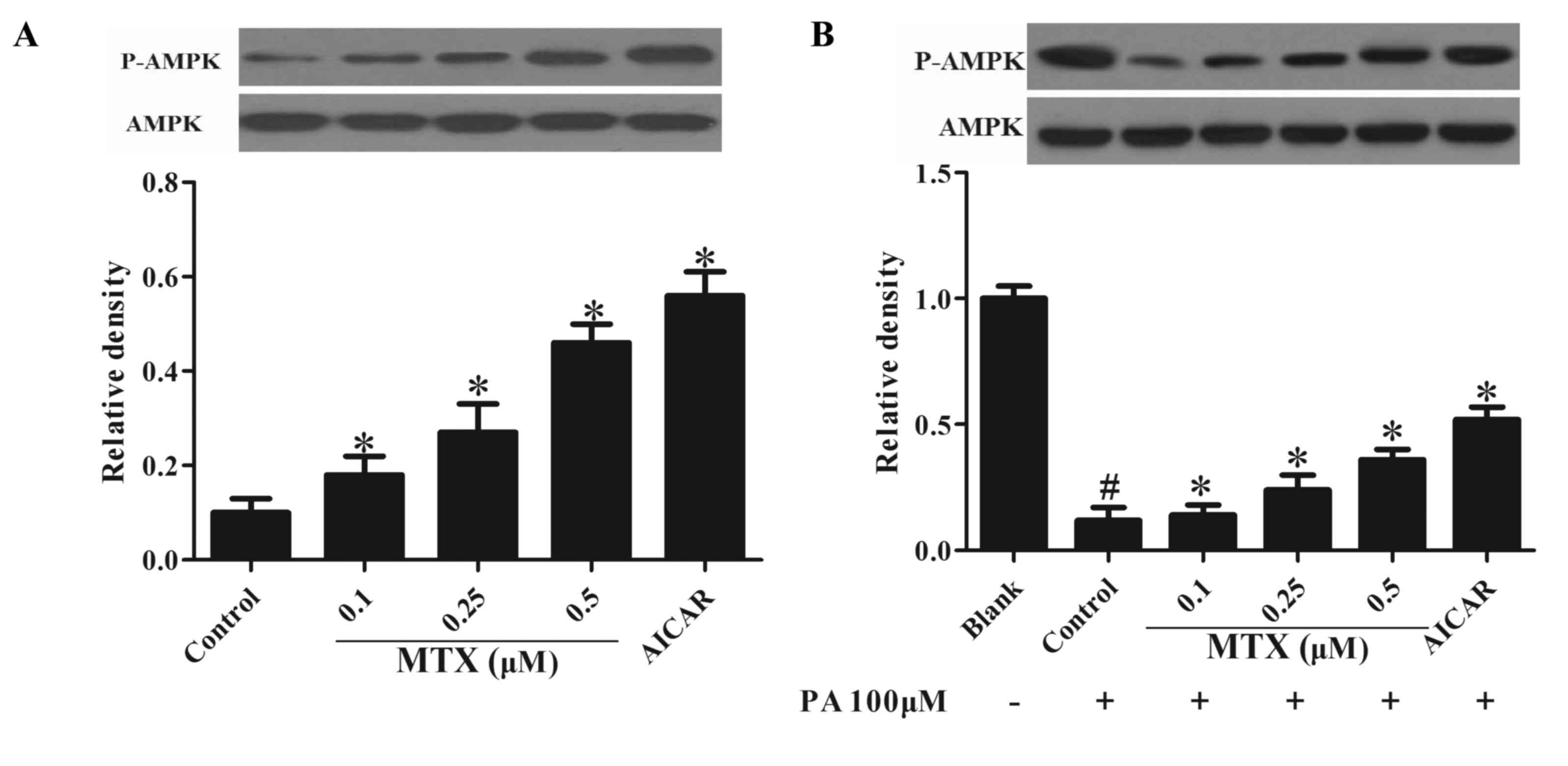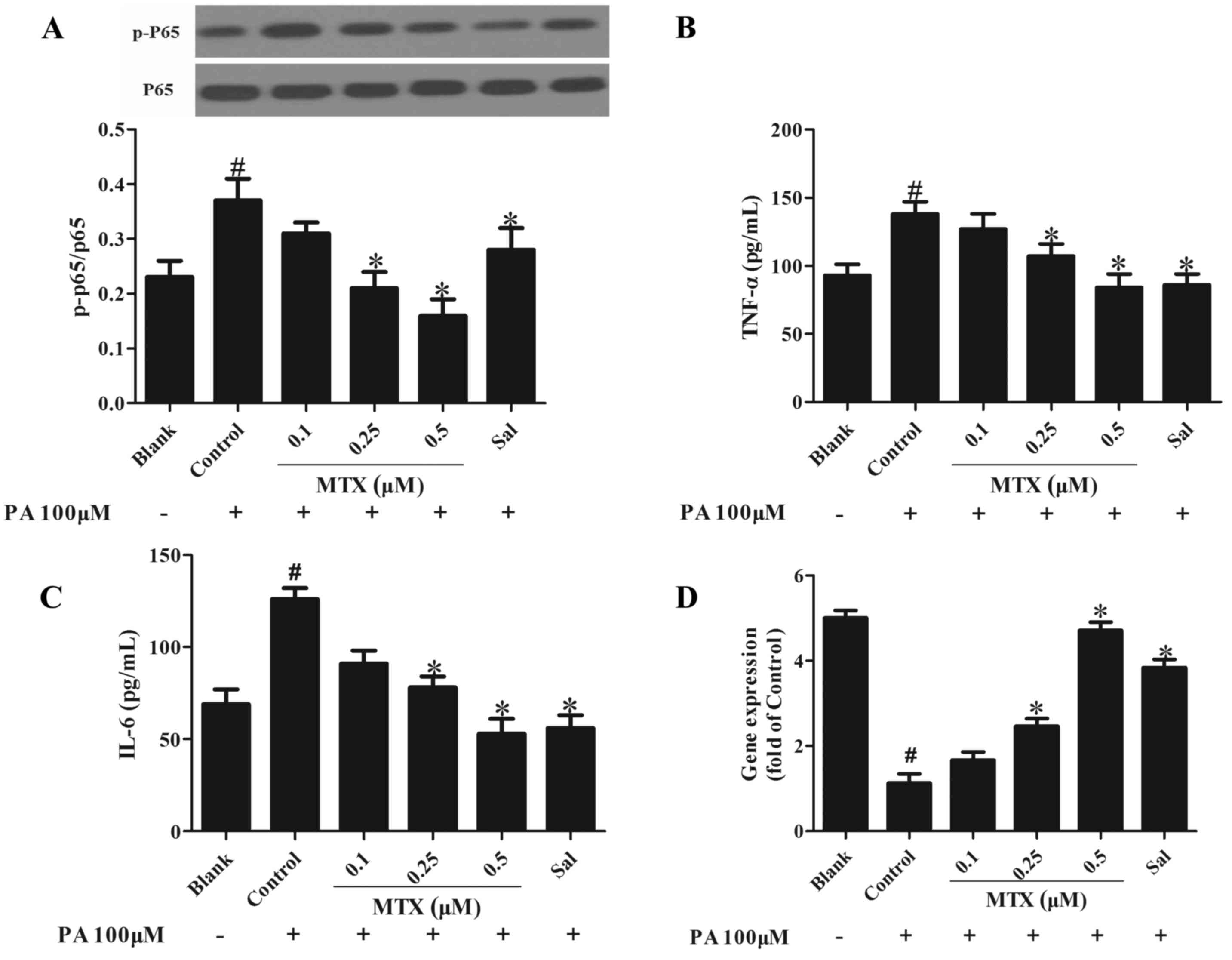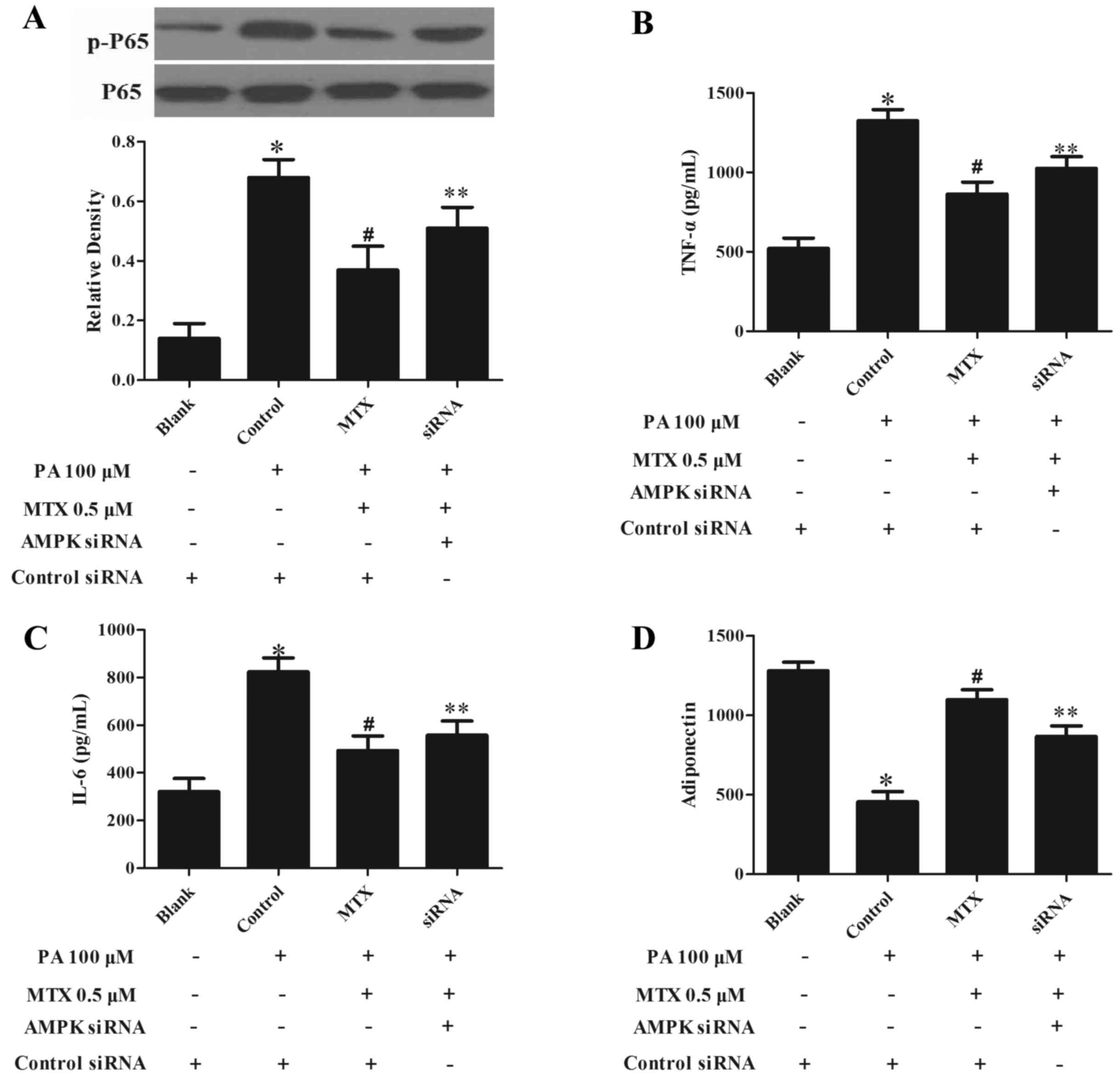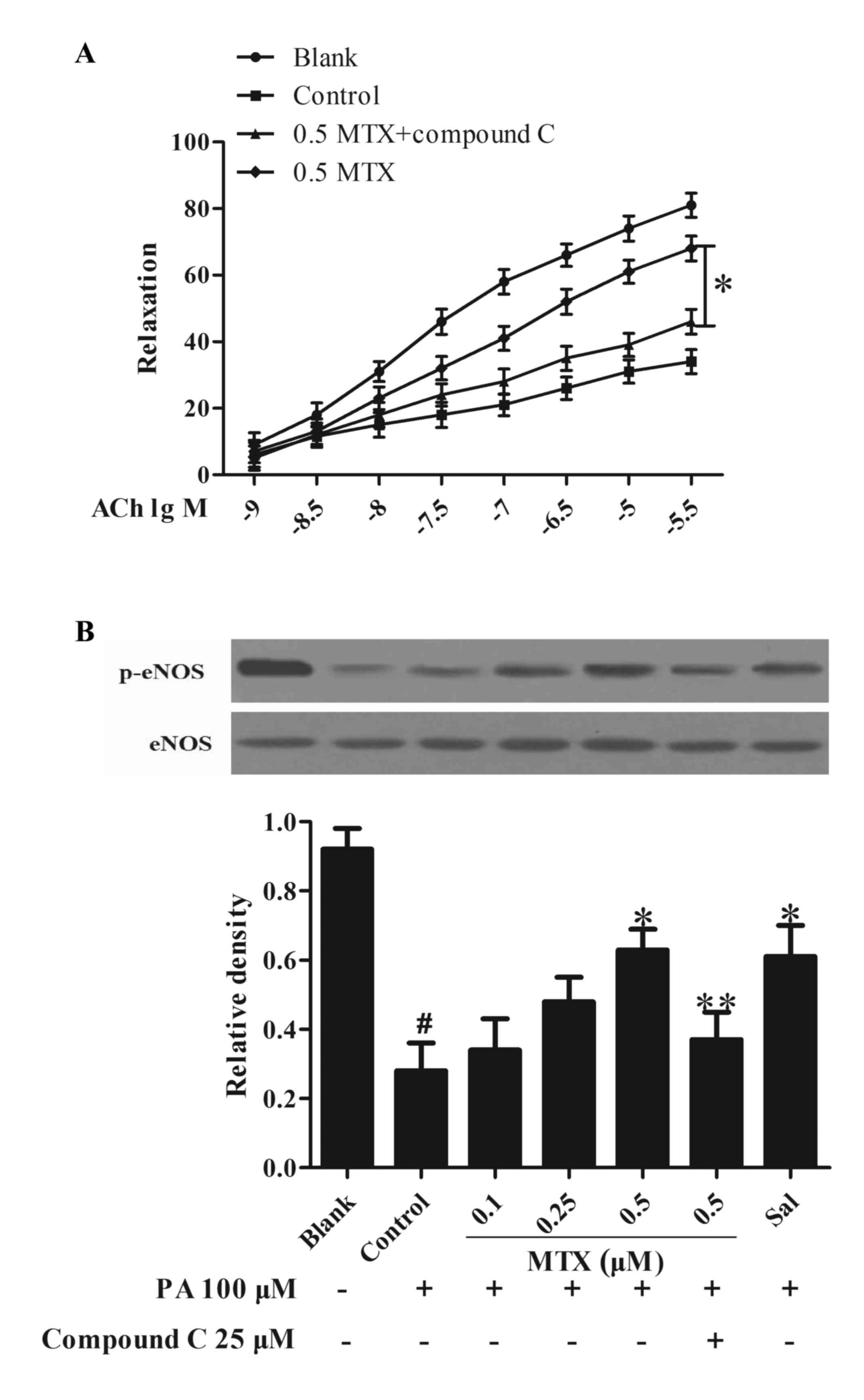Methotrexate improves perivascular adipose tissue/endothelial dysfunction via activation of AMPK/eNOS pathway
- Authors:
- Published online on: February 21, 2017 https://doi.org/10.3892/mmr.2017.6225
- Pages: 2353-2359
Abstract
Introduction
Inflammation results in the initiation and progression of atherosclerosis. Atherosclerosis is the primary cause of cardiovascular disease and conditions that affect the cerebral, coronary and peripheral vasculature, and is the most common cause of morbidity and mortality worldwide (1). Endothelial dysfunction is characterized by reduced endothelial nitric oxide (NO) synthase (eNOS)-derived NO bioactivity, and the impairment of endothelium-dependent vascular dysfunction is the progenitor of atherogenesis (2). Approaches designed to improve endothelial function are expected to have therapeutic value in the prevention or treatment of atherosclerosis (3). Perivascular adipose tissue (PVAT) directly surrounds vessels and influences their function via a paracrine effect.
Adenosine monophosphate-activated protein kinase (AMPK) is an important regulator of energy metabolic homeostasis and emerging evidence demonstrates its anti-inflammatory action in vessel and adipose tissue (4,5). AMPK may modulate a number of signaling cascades that are expected to have anti-endothelial cell dysfunction, including the attenuation of free radicals (6). In a preliminary experiment, the authors demonstrated that pharmacological activation of AMPK beneficially regulated adipocytokine expression in PVAT against inflammatory insult and ameliorated endothelial dysfunction. These findings demonstrated the role of AMPK activation in the regulation of PVAT and endothelial function (7).
Methotrexate (MTX), a non-specific anti-inflammatory therapy, may be an ideal agent to directly test the inflammatory hypothesis of atherosclerosis, as it inhibits inflammation with only minimal impact on other components of the atherosclerotic process and exhibits an acceptable safety profile (8,9). A recent pre-clinical study with cholesterol-fed rabbits revealed that MTX markedly reduced atherosclerosis, without effects on plasma lipid and lipoprotein levels (10). The Cardiovascular Inflammation Reduction Trial evaluates the use of very low-dose MTX on cardiovascular events and plasma lipid levels in coronary artery disease patients with elevated C-reactive protein levels and is expected to offer more conclusive results in the future (9).
The present study investigated the effect of MTX on AMPK activation and adipocytokine expression in PVAT with emphasis on the regulation of endothelial function. It was observed that MTX ameliorated endothelial dysfunction by inhibiting inflammation in PVAT. These findings provide novel information regarding the underlying mechanism of MTX in the management of cardiovascular diseases.
Materials and methods
Animals
Sprague-Dawley male rats (n=24; 8-weeks old; weight, 200–250 g) were supplied by the Laboratory Animal Center of Nanjing Qinglongshan (Nanjing, China). The care and treatment of these rats was performed in accordance with the Provisions and General Recommendation of Chinese Experimental Animals Administration Legislation. All animals were housed in a room with a constant temperature (22±1°C) and a humidity of 50±%, allowed access to a standard diet and water ad libitum, and exposed to a 12-h light/dark cycle. The present study was approved by the Ethics Committee of Ninth Hospital of Xi'an (Xi'an, China).
Preparation of PVAT-derived conditioned medium (CM)
Sprague-Dawley rats were anesthetized with diethyl ether and sacrificed by cervical dislocation. PVAT (located around the thoracic aorta) was isolated, sectioned into small pieces and rinsed in phosphate buffered saline (PBS). Equal quantities (40 mg) of PVAT were individually pretreated with MTX (Sigma-Aldrich; Merck Millipore, Darmstadt, Germany) (0.1, 0.25 and 0.5 µM) or salicylate (5 mM; Tianjin Kemiou Chemical Reagent Co., Ltd., Tianjin, China) or aminoimidazole-4-carboxamide ribonucleotide (AICAR; 500 µM; Sigma-Aldrich, Merck Millipore) in the presence or absence of 25 µM AMPK inhibitor compound C (Sigma-Aldrich; Merck Millipore) and stimulated with 100 µM palmitic acid (PA; Sinopharm Chemical Reagent Co., Ltd., Shanghai, China) for 2 h. Following treatment, the PVAT was washed twice with PBS to remove the reagents, and cultured in fresh Dulbecco's modified Eagle's medium (DMEM, Gibco; Thermo Fisher Scientific, Inc., Waltham, MA, USA) supplemented with 10% (v/v) fetal bovine serum (FBS) for 22 h at 37°C. The medium was collected as CM. The supernatant was then collected as conditioned CM and stored at −70°C.
Endothelium-dependent relaxation assessment
Endothelium-dependent relaxation was assayed as previously described (7). Briefly, the prepared aortic ring was suspended in an organ bath containing 10 ml K-H solution (118.3 mM NaCl, 4.7 mM KCl, 1.2 mM MgSO4, 1.2 mM KH2PO4, 2.5 mM CaCl2, 25 mM NaHCO3, 0.026 mM calcium disodium EDTA and 5.0 mM glucose, pH 7.4) maintained at 37°C pH 7.4, and continuously aerated with 95% O2 and 5% CO2. Following a 60 min stabilization period, the contractive ability of the vessel was examined by contractive response to 60 mM KCl, and the functionality of vascular endothelium was confirmed by relaxation to 10 µM acetylcholine (ACh; Sigma-Aldrich; Merck Millipore). The aortic ring (relaxation, ≥80%) was treated with CM for 30 min. Following washing, the aortic ring was pre-contracted with phenylephrine and the endothelium-dependent relaxation was induced by cumulative addition of ACh (0.001–10 µM). Relaxation was expressed as a percentage of the phenylephrine-induced contraction.
Cell culture
3T3-L1 pre-adipocytes were purchased from the Cell Bank of the Chinese Academy of Sciences (Shanghai, China). A total of 2×105/ml cells were cultured in 6-well plates in DMEM containing 10% FBS and 25 mM glucose at 37°C in a humidified atmosphere containing 5% CO2.
RNA extraction and reverse transcription-quantitative polymerase chain reaction (RT-qPCR)
PVAT from rats were pretreated with MTX in the presence of PA (100 µM) for 2 h. Following washing with PBS, PVAT was cultured in fresh DMEM supplemented with 10% (v/v) FBS for 22 h. PVAT was then collected and homogenized with 500 µl TRIzol® (Invitrogen; Thermo Fisher Scientific, Inc.) on ice. Total RNA was obtained using Total RNA Extraction Reagent (Nanjing Sunshine Biotechnology Co., Ltd., Nanjing, China). cDNA was synthesized with the TransScript First-strand cDNA Synthesis SuperMix kit (Beijing Transgen Biotech Co., Ltd., Beijing, China). qPCR was performed using SsoFast™ EvaGreen Supermix (Bio-Rad Laboratories Inc., Hercules, CA, USA). Amplification was performed with the Bio-Rad iQ5 sequence detection system (Bio-Rad Laboratories Inc.) with the following conditions: 95°C for 10 min, followed by 40 cycles at 95°C for 30 sec, and 52°C for 15 sec, and a final extension at 72°C for 5 min. The following primers were used: Adiponectin forward, 5′-AAGGGGACAACAATGGACTCTA-3′, and reverse, 5′-CTACGGGCTGCTCTGAATTAGT-3′; β-actin forward, 5′-GACGTTGACATCCGTAAAGACC-3′, and reverse, 5′-TGCTAGGAGCCAGGGCAGTA-3′. The mRNA expression level of individual genes was normalized and presented as a ratio to β-actin, and calculated using the 2-ΔΔCq method (11).
Western blot analysis
PVAT from Sprague-Dawley rats was pretreated with MTX for 30 min and then incubated with PA for a further 30 min. The aorta was incubated with CM for 30 min and then exposed to ACh for another 30 min. PVAT was isolated directly following the sacrifice of the rats. For protein analysis, PVAT or the aorta was homogenized in radio immunoprecipitation assay lysis buffer with phenylmethane sulfonyl fluoride. Protein concentration in the supernatants was assayed using Bicinchoninic Acid Protein Assay kit (Nanjing Baxi Technology Co., Ltd. Nanjing, China). Equal amounts of protein (30 µg) were separated by 10% SDS-PAGE and transferred to 0.45 µM polyvinylidene difluoride (PVDF) membranes (EMD Millipore, Billerica, MA, USA) by semi-dry electrophoretic transfer (Bio-Rad Laboratories, Inc.). The PVDF membranes were blocked with 5% non-fat milk in Tris-buffered saline with Tween-20 (TBST) and then incubated with the appropriate primary antibodies overnight at 4°C: Rabbit monoclonal anti-phospho-AMPK (cat. no. 2531) and anti-AMPK (cat. no. 2532), rabbit monoclonal anti-eNOS (cat. no. 9586) and anti-p-eNOS (cat. no. 9571), anti-NF-κB p65 (cat. no. 4764) and anti-p-NF-kB p65 (cat. no. 3033; all at 1:1,000 and obtained from Cell Signaling Technology, Inc., Beverly, MA, USA). The PVDF membrane was washed three times with TBST buffer and then incubated with the HRP-conjugated secondary antibodies (cat. no. BS13278; 1:10,000, MyBioSource, Inc., San Diego, CA, USA) at room temperature for 2 h. The membranes were developed with an enhanced chemiluminescence detection reagent (Thermo Fisher Scientific, Inc.) and quantitated by densitometry with Image-Pro Plus 6.0 software (Media Cybernetics, Inc., Rockville, MD, USA).
ELISA assay
The levels of TNF-α and IL-6 in the supernatant were assayed with commercial enzyme-linked immunosorbent assay (ELISA) kits (R&D, Minneapolis, MN, USA).
AMPK small interfering (si)RNA transfection
3T3-L1 pre-adipocytes were transfected with siRNA for AMPKα (cat. no. sc-45313) to knock down levels of endogenous AMPKα, and negative control siRNA (cat. no. sc-37007), using siRNA transfection reagent (cat. no. sc-29528) in transfection medium (cat. no. sc-36868) for 6 h, according to the manufacturer's protocol. All siRNAs were obtained from Santa Cruz Biotechnology, Inc., Dallas, TX, USA. Following an additional 48 h, the efficiency of siRNA-mediated AMPK knockdown was confirmed by western blot analysis as aforementioned.
Statistical analysis
Data were expressed as the mean ± standard deviation from at least three independent experiments. SPSS version 13.0 software (SPSS, Inc., Chicago, IL, USA) was used for the statistical analysis. Individual group statistical comparisons were analyzed using an unpaired Student's t-test with Bonferroni correction and multiple-group comparisons were evaluated by one-way analysis of variance followed by Tukey's post-hoc test. P<0.05 was considered to indicate a statistically significant difference.
Results
MTX regulates AMPK activation in PVAT
AMPK is important in the regulation of lipid metabolism, therefore the present study first investigated the effect of MTX on AMPK activity in PVAT. As presented in Fig. 1A, MTX treatment increased basal AMPK activity at concentrations ranging from 0.1 to 0.5 µM, indicated by enhanced AMPK phosphorylation. In addition, it was observed that when PVAT was exposed to PA, a reduction of AMPK phosphorylation was observed, and this alteration was prevented by pretreatment with MTX (P<0.05, Fig. 1B). Furthermore, treatment with AICIR which is an AMPK agonist, exhibited similar effects (P<0.05). These results indicated that MTX enhanced AMPK activation under basal and inflammatory conditions.
MTX inhibits inflammation and modulates adipocytokine expression in PVAT
It has previously been demonstrated that free fatty acids induce inflammation in the endothelium via the nuclear factor (NF)-κB pathway and stimulation with PA enhanced phosphorylation of NF-κB p65 in PVAT (12). As presented in Fig. 2A, MTX effectively reduced NF-κB p65 phosphorylation, indicative of its anti-inflammatory activity (P<0.05). In addition, the effect of MTX on the expression of adipocytokines implicated in inflammation was examined. As presented in Fig. 2B and C, the expression levels of pro-inflammatory cytokines, including tumor necrosis factor (TNF)-α and interleukin (IL)-6, were increased in cells treated with PA for 24 h and this was reversed by MTX pretreatment (P<0.05), demonstrating its anti-inflammatory activity. Furthermore, the expression of adiponectin was downregulated, however these alterations were reversed by treatment with MTX (P<0.05, Fig. 2D).
AMPK silencing blocks the anti-inflammatory effect of MTX
The AMPK inhibitor to confirm the role of AMPK in the anti-inflammatory effect of MTX, 3T3-L1 cells were transfected with AMPKa1/2-specific siRNA to knockdown AMPK expression. As presented in Fig. 3A, silencing AMPK significantly decreased the inhibitory effect of MTX on PA-mediated NF-κB p65 phosphorylation (P<0.05). MTX treatment altered the production of TNF-α (Fig. 3B), IL-6 (Fig. 3C) and adiponectin (Fig. 3D) upon PA challenge, however, this action was also blocked by knockdown of AMPK (P<0.05, Fig. 3B-D). These results indicated that MTX inhibited inflammation in a AMPK-dependent manner.
Treatment of PVAT with MTX restores the loss of ACh-induced vasodilation
Endothelial dysfunction is characterized by the loss of endothelium-dependent vasodilation. To investigate the influence of PVAT on vessel function, PVAT was incubated with PA and collected the medium as CM to stimulate the rat aorta. Data presented in Fig. 4A indicated that ACh induced vasodilation, whereas stimulation with PA led to a significant loss in vessel relaxation (P<0.05). Pretreatment of PVAT with MTX prevented the alterations and effectively restored the loss of ACh-mediated vessel relaxation in a concentration-dependent manner, but this action was attenuated by co-treatment with AMPK inhibitor compound C (P<0.05, Fig. 4A). Furthermore, it was observed that treating PVAT with MTX effectively normalized eNOS phosphorylation in the aorta subjected to CM challenge (P<0.05, Fig. 4B). AMPK inhibitor compound C blocked the actions of MTX in the regulation of vasodilation and eNOS phosphorylation, suggesting the involvement of AMPK in the mechanism of MTX action. These results suggested that MTX improved vessel function via regulation of AMPK activity.
Discussion
Endothelial homeostasis is important in the regulation of vessel function and may predict the development of cardiovascular diseases independently of other known risk factors (13). PVAT is a functional component of the vasculature, exerting paracrine influences on endothelial homeostasis. A previous study has investigated the regulation of vessel tone by PVAT, attempting to identify adipocyte-derived relaxation and constriction factors, which are endothelium-independent (14). Inflammation in PVAT induces dysregulation of adipocytokine expression and subsequently impairs the integrity of the endothelium, which results in its dysfunction. The present study prepared an ex vivo model of PVAT/endothelial dysfunction by treating rat aorta with PVAT-derived CM and successfully observed the beneficial effects of MTX on adipocytokine expression and further implications in endothelial function.
In addition to regulating energy metabolism, AMPK exerts anti-inflammatory activity, and this action has been implicated in the normalization of adipose and endothelial functions. The present study first investigated the role of MTX in the regulation of AMPK activation in PVAT, and observed that AMPK activity was increased by enhancing phosphorylation. PA stimulation was demonstrated to reduce AMPK phosphorylation in PVAT, consistent with results from a previous study (15).
It has previously been demonstrated that nanomolar concentrations of NO have anti-inflammatory and protective properties that are mediated by the inhibition of the activation of NF-κB (16). PA stimulation evoked inflammation in PVAT, which induced adipose dysfunction as demonstrated by enhanced NF-κB p65 phosphorylation. MTX attenuated NF-κB p65 phosphorylation, suggesting the inhibition of NF-κB inflammatory signaling. This finding is consistent with a previous study in which PA induced NF-κB-dependent inflammation by binding to toll-like receptor 4 in the endothelium (17). The expression levels of pro-inflammatory adipocytokines, including TNF-α and IL-6, were increased, whereas gene expression levels of adiponectin were downregulated. MTX reversed the alteration of adipocytokine expression, exhibiting a similar effect to that induced by salicylate, demonstrating its anti-inflammatory potency in the endothelium. To further elucidate the role of AMPK in the anti-inflammatory activity of MTX, the activity of MTX in adipocytes was observed. AMPKα knockdown using siRNA diminished the inhibitory effect of MTX on NF-κB activation and blocked its beneficial regulation of TNF-α, IL-6 and adiponectin production, further verifying the role of AMPK in the anti-inflammatory activity of MTX.
Endothelial dysfunction is characterized by the loss of endothelium-dependent vasodilation (18,19). eNOS-derived NO, which is a gaseous signaling molecule, is important in the maintenance of vascular homeostasis by promoting vasodilation and inhibiting inflammation (20). Therefore, in order to observe the effects of AMPK agents on endothelial homeostasis via regulation of PVAT function, the present study stimulated PVAT with MTX and collected the medium as CM to treat rat aorta. Furthermore, ACh-induced endothelium-dependent vasodilation is mediated via eNOS activation and subsequent NO production. Pretreatment of PVAT with PA reduced eNOS phosphorylation and impaired ACh-mediated vasodilation, indicating the association between dysregulation of adipocytokine expression and endothelial dysfunction. Co-treatment with the AMPK inhibitor compound C blocked the action of MTX on vasodilation, further demonstrating the involvement of AMPK in its regulation.
In conclusion, the present study established an ex vivo model of PVAT/endothelial dysfunction by stimulating rat aorta with CM derived from PVAT. It was demonstrated that pharmacological activators of AMPK regulated adipocytokine expression by inhibiting PVAT inflammation, and thereby ameliorated endothelial dysfunction in an AMPK interdependent manner. These findings provide a novel insight into the potential underlying mechanism by which MTX protects endothelial function against inflammatory insult.
References
|
World Health Statistics, . 2012, World Health Organization. Geneva: 2012 | |
|
Vita JA and Keaney JF: Endothelial function: A barometer for cardiovascular risk? Circulation. 106:640–642. 2002. View Article : Google Scholar : PubMed/NCBI | |
|
Li AC and Glass CK: The macrophage foam cell as a target for therapeutic intervention. Nat Med. 8:1235–1242. 2002. View Article : Google Scholar : PubMed/NCBI | |
|
Bijland S, Mancini SJ and Salt IP: Role of AMP-activated protein kinase in adipose tissue metabolism and inflammation. Clin Sci (Lond). 124:491–507. 2013. View Article : Google Scholar : PubMed/NCBI | |
|
Gauthier MS, O'Brien EL, Bigornia S, Mott M, Cacicedo JM, Xu XJ, Gokce N, Apovian C and Ruderman N: Decreased AMP-activated protein kinase activity is associated with increased inflammation in visceral adipose tissue and with whole-body insulin resistance in morbidly obese humans. Biochem Bioph Res Commun. 404:382–387. 2011. View Article : Google Scholar | |
|
Tsai KL, Chen LH, Chiou SH, Chiou GY, Chen YC, Chou HY, Chen LK, Chen HY, Chiu TH, Tsai CS, et al: Coenzyme Q10 suppresses oxLDL-induced endothelial oxidative injuries by the modulation of LOX-1-mediated ROS generation via the AMPK/PKC/NADPH oxidase signaling pathway. Mol Nutr Food Res. 55 Suppl 2:S227–S240. 2011. View Article : Google Scholar : PubMed/NCBI | |
|
Sun Y, Li J, Xiao N, Wang M, Kou J, Qi L, Huang F, Liu B and Liu K: Pharmacological activation of AMPK ameliorates perivascular adipose/endothelial dysfunction in a manner interdependent on AMPK and SIRT1. Pharmacol Res. 89:19–28. 2014. View Article : Google Scholar : PubMed/NCBI | |
|
Saag KG, Teng GG, Patkar NM, Anuntiyo J, Finney C, Curtis JR, Paulus HE, Mudano A, Pisu M, Elkins-Melton M, et al: American College of Rheumatology 2008 recommendations for the use of nonbiologic and biologic disease-modifying antirheumatic drugs in rheumatoid arthritis. Arthritis Rheum. 59:762–784. 2008. View Article : Google Scholar : PubMed/NCBI | |
|
Ridker PM: Testing the inflammatory hypothesis of atherothrombosis: Scientific rationale for the cardiovascular inflammation reduction trial (CIRT). J Thromb Haemost. 7 Suppl 1:S332–S339. 2009. View Article : Google Scholar | |
|
Bulgarelli A, Dias AA Martins, Caramelli B and Maranhão RC: Treatment with methotrexate inhibits atherogenesis in cholesterol-fed rabbits. J Cardiovasc Pharmacol. 59:308–314. 2012. View Article : Google Scholar : PubMed/NCBI | |
|
Livak KJ and Schmittgen TD: Analysis of relative gene expression data using real-time quantitative PCR and the 2(−Delta Delta C(T)) method. Methods. 25:402–408. 2001. View Article : Google Scholar : PubMed/NCBI | |
|
Mugabo Y, Mukaneza Y and Renier G: Palmitate induces C-reactive protein expression in human aortic endothelial cells. Relevance to fatty acid-induced endothelial dysfunction. Metabolism. 60:640–648. 2011. View Article : Google Scholar : PubMed/NCBI | |
|
Calles-Escandon J and Cipolla M: Diabetes and endothelial dysfunction: A clinical perspective. Endocr Rev. 22:36–52. 2001. View Article : Google Scholar : PubMed/NCBI | |
|
Gollasch M: Vasodilator signals from perivascular adipose tissue. Br J Pharmacol. 165:633–642. 2012. View Article : Google Scholar : PubMed/NCBI | |
|
Steinberg GR, Michell BJ, van Denderen BJ, Watt MJ, Carey AL, Fam BC, Andrikopoulos S, Proietto J, Görgün CZ, Carling D, et al: Tumor necrosis factor alpha-induced skeletal muscle insulin resistance involves suppression of AMP-kinase signaling. Cell Metab. 4:465–474. 2006. View Article : Google Scholar : PubMed/NCBI | |
|
Peng HB, Libby P and Liao JK: Induction and stabilization of I kappa B alpha by nitric oxide mediates inhibition of NF-kappa B. J Biol Chem. 270:14214–14219. 1995. View Article : Google Scholar : PubMed/NCBI | |
|
Maloney E, Sweet IR, Hockenbery DM, Pham M, Rizzo NO, Tateya S, Handa P, Schwartz MW and Kim F: Activation of NF-kappaB by palmitate in endothelial cells: A key role for NADPH oxidase-derived superoxide in response to TLR4 activation. Arterioscl Throm Vas Biol. 29:1370–1375. 2009. View Article : Google Scholar | |
|
Félétou M and Vanhoutte PM: Endothelial dysfunction: A multifaceted disorder (The Wiggers Award Lecture). Am J Physiol Heart Circ Physiol. 291:H985–H1002. 2006. View Article : Google Scholar : PubMed/NCBI | |
|
Cersosimo E and DeFronzo RA: Insulin resistance and endothelial dysfunction: The road map to cardiovascular diseases. Diabetes Metab Res Rev. 22:423–436. 2006. View Article : Google Scholar : PubMed/NCBI | |
|
Moncada S: Nitric oxide in the vasculature: Physiology and pathophysiology. Ann NY Acad Sci. 811:60–69. 1997. View Article : Google Scholar : PubMed/NCBI |













